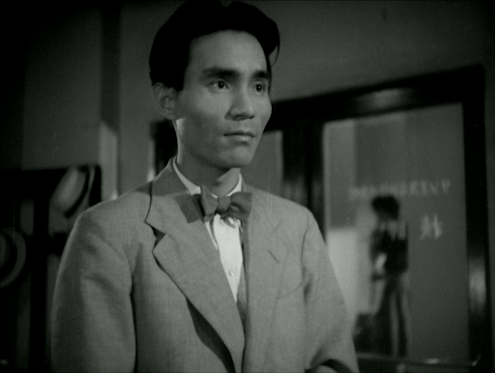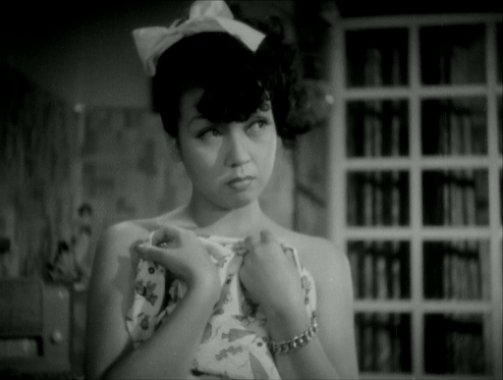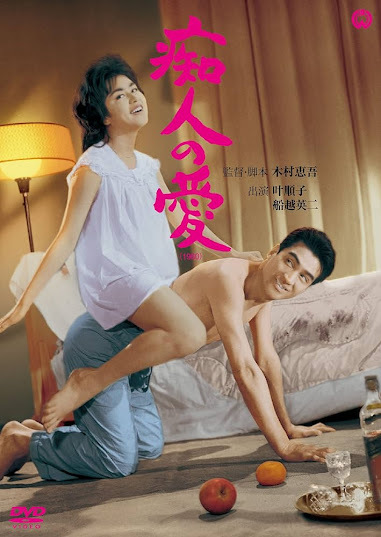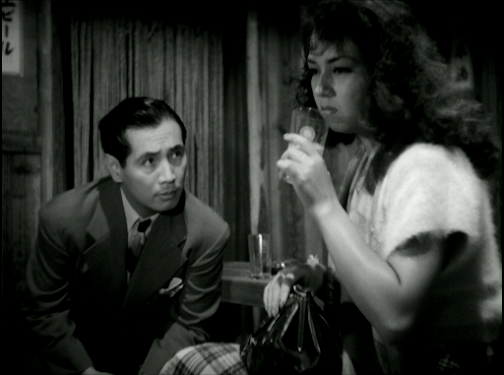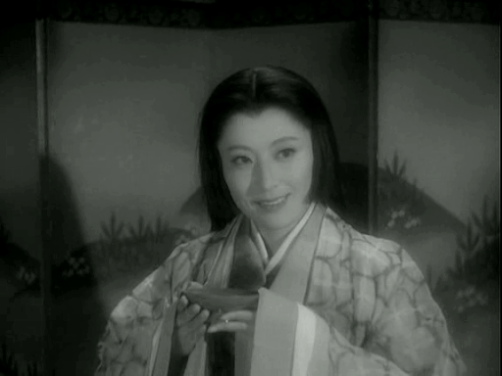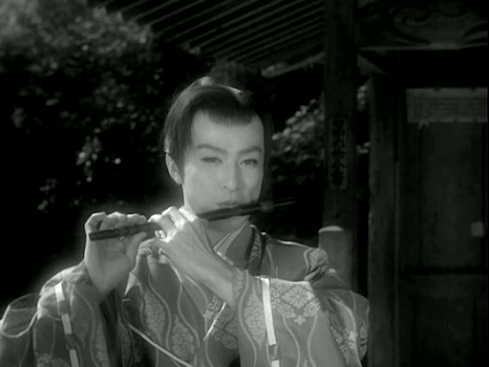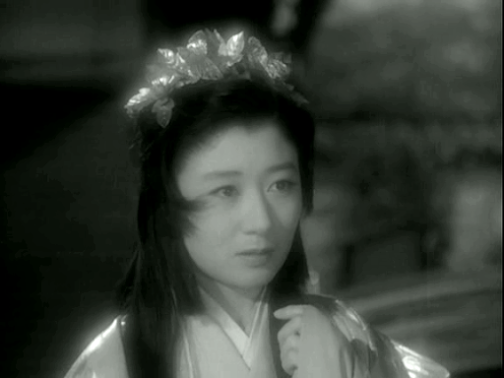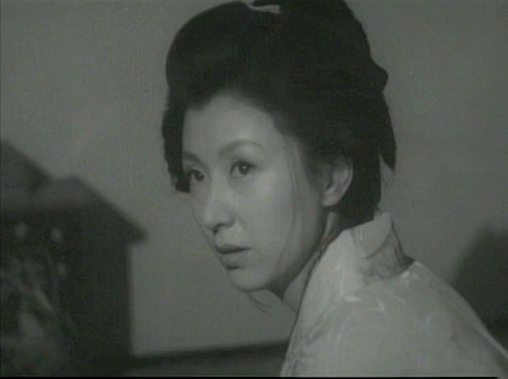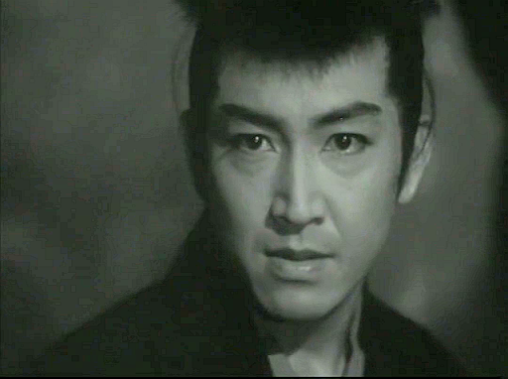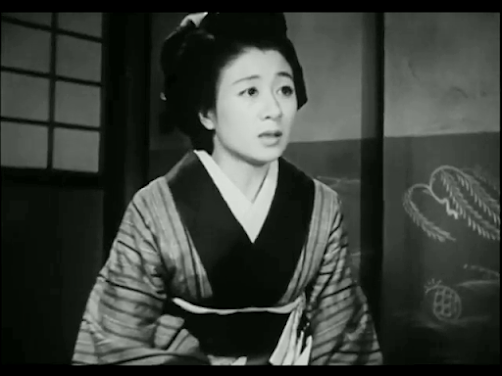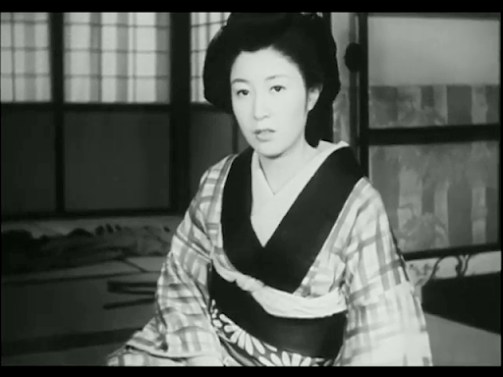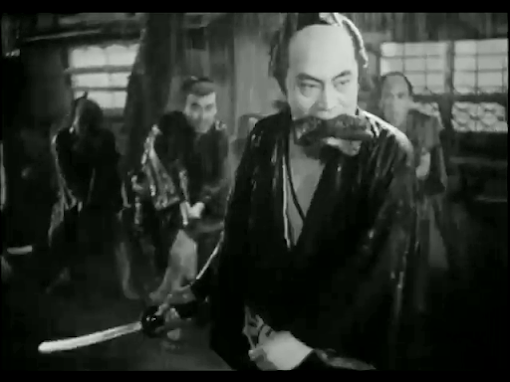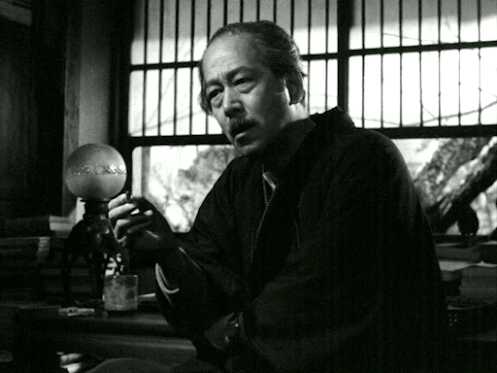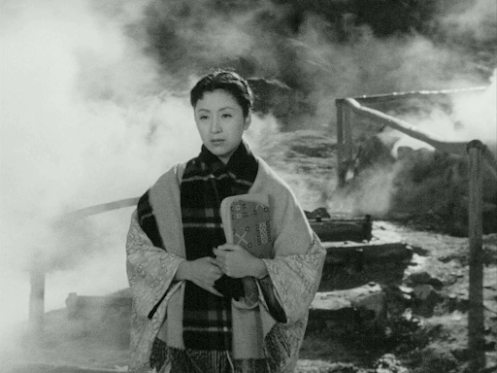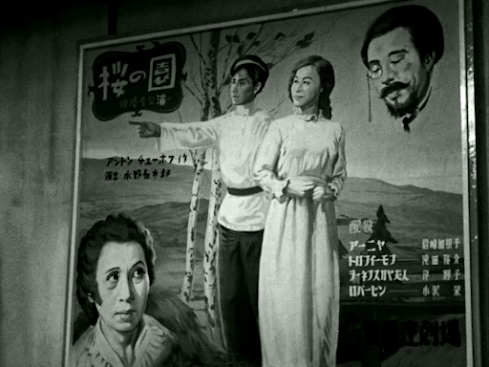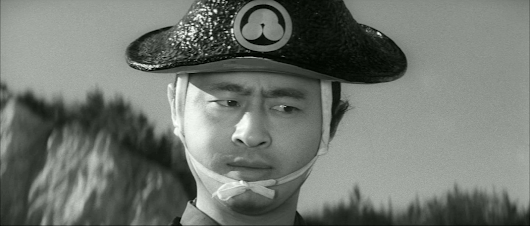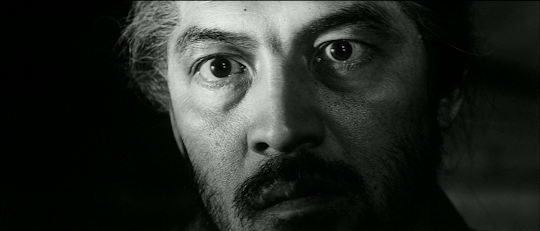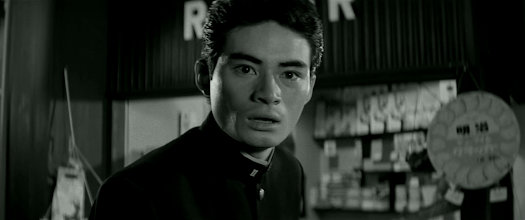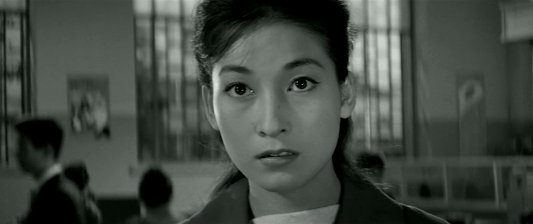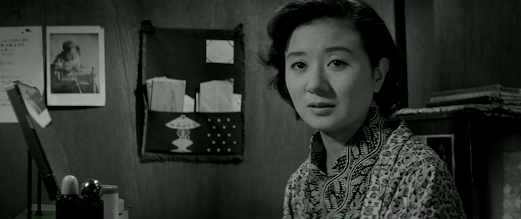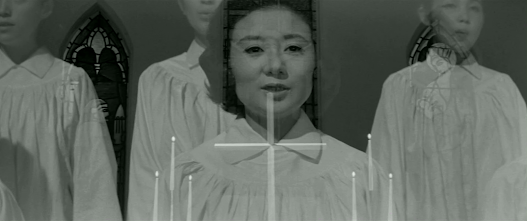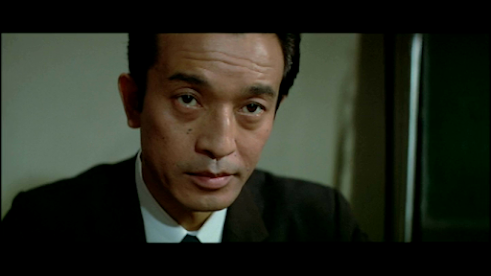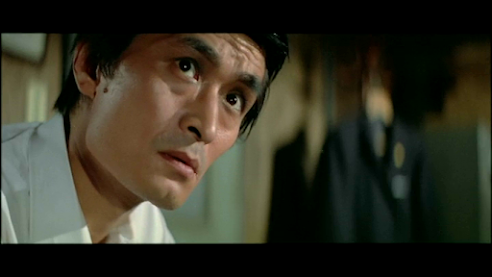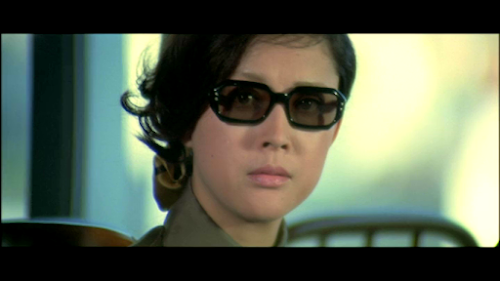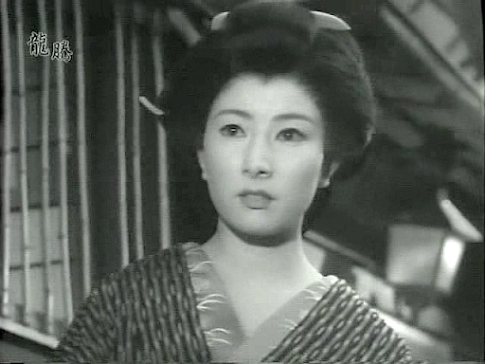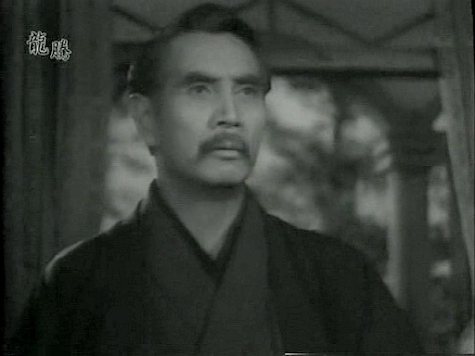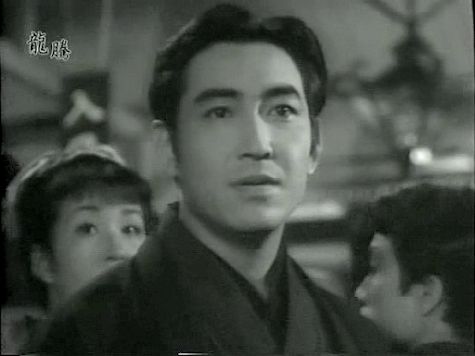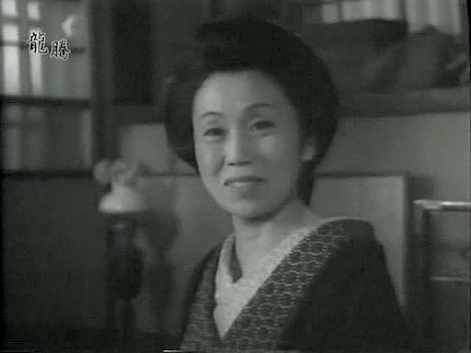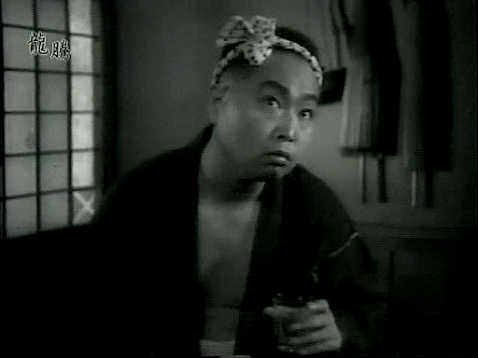M.R. Dowsing's Blog, page 13
February 1, 2024
A Fool’s Love / 痴人の愛 / Chijin no ai (1949)
Obscure Japanese Film #99
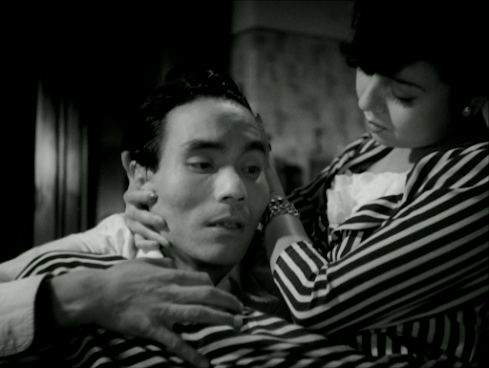
Chijinno ai is the earliest film version of the well-knownnovel of the same name by one of Japan’s most acclaimed writers, JunichiroTanizaki. First published in 1925, it’s a first-person narrative in which Joji,a salaryman with a well-paid management position, relates the storyof his obsession with Naomi, whom he first meets at a café inAsakusa where she works as a waitress. Naomi is only 15 at the time, but the 28-year-old Joji’srespectability enables him to make a deal with her mother whereby he will takeher in and pay for her education. He promises not to seek sexual favours fromNaomi until she is older and she consents, at which point he will marry her if sheagrees. In the meantime, he plans to mould her into his ideal woman. However,this proves to be more difficult than he had bargained for due to Naomi’swilful and uncooperative behaviour. She soon has Joji wrapped around her littlefinger, and he remains infatuated despite the humiliations she causes him.
Chijinno ai is often understandably compared to Nabokov’s Lolita, but pre-dates it by 30 years. Thesimilarities between the two appear to be entirely coincidental as Tanizaki’snovel was not translated until 1985, when it appeared in English under thetitle Naomi. This film version fromDaiei studios updates the story to contemporary post-war Japan and begins withJoji (Jukichi Uno) and Naomi (Machiko Kyo) already living together. As Machiko Kyo wasalready 25 at this point, the age difference between the two characters is muchless pronounced than in the book.
This was already Kyo’sfifth picture since being signed as a ‘new face’ by Daei the same year; evenbefore that, she had built up years of stage experience as a member of theOsaka Shochiku Girls’ Opera Company, which she had joined in 1936 at the age of12. As a member of that company, she had also appeared in two Shochiku films, Tengu daoshi and Danjuro Mitsuyo (both 1944), the latter of which was directed by noneother than Kenji Mizoguchi (and is presumably lost as there seems to be verylittle information about it online). Althoughthe part of Naomi was not Kyo’s first leading role in a film, in the light ofits prestigious literary origin it seems fair to say that it was her firstreally important one. In any case, the confidence with which this apparentnewcomer performs the role is perhaps not so surprising given that she hadalready been performing for 13 years by the time the film was made.
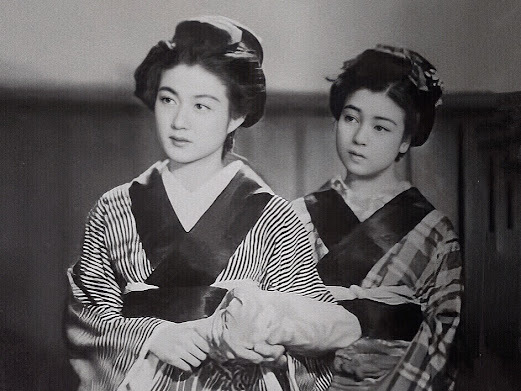 Machiko Kyo (right) in Tengu daoshi
Machiko Kyo (right) in Tengu daoshi
The director, KeigoKimura (1903-86) appears to have played a significant part in Kyo’s career. Notonly did he choose her to play Naomi, but he had already directed her oncepreviously and would go on to make a total of 10 films with her, including thepreviously-reviewed Life of a HorseTrader. He would also remake A Fool’sLove in 1960 with Eiji Funakoshi, and Junko Kano as Naomi, and his reasonsfor doing so were not merely to repeat an earlier success.
In the original novel,one of the attractions for Joji in pursuing Naomi is that she has a somewhatWestern appearance – in fact, he thinks she resembles Mary Pickford!Furthermore, Naomi is, of course, also a female given name in English-speakingcountries, and Joji pays for her to have English lessons. While I wouldn’t goso far as to claim that Naomi is simply a metaphor representing Western values,it’s certainly the case that Tanizaki was commenting on the way many Japanesewere embracing Western culture at the time, sometimes at the expense of theirown. At the end of the book, Joji is completely dominated by Naomi and becomesher willing slave, whereas at the end of the 1949 film, Naomi recognises theerror of her ways and submits to Joji, promising to be a good girl from now on.As the film was made during the American occupation, there was no way the authoritieswere going to approve a film which could be interpreted as a warning aboutAmerican domination. For this reason – and also because the age difference ismuch less of an issue than in the book – Keigo Kimura’s first attempt atfilming Tanizaki’s novel is considerably compromised. Although I’ve yet to seehis later version, I understand that it is indeed more faithful to the book,especially in regard to the ending.
This first version is alittle slow at times, with not much sense of pacing, but there are someinteresting sequences, such as the montage in which we see the gradualdeterioration of Naomi’s stockings reflecting the change in her circumstancesafter she leaves Joji. The main interest of the film today is likely to be thechance to see Kyo in an early leading role, but Jukichi Uno also gives a goodaccount of himself as do Masayuki Mori and Koji Mitsui as Naomi’s malefriends-from-hell, a couple of pleasure-seeking parasites who abandon her assoon she’s down on her luck.
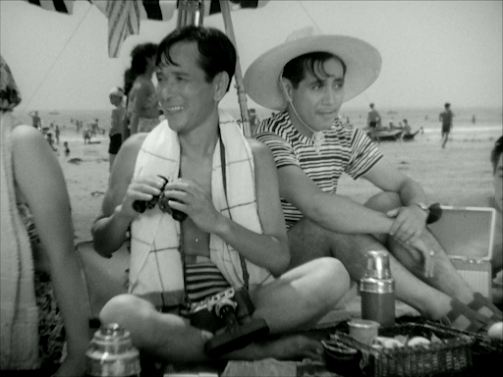 Koji Mitsui and Masayuki Mori
Koji Mitsui and Masayuki MoriTwo further filmversions were made: Yasuzo Masumura’s 1967 film* starring Shoichi Ozawa andMichiyo Yasuda, which is more of a comedy, and a semi-porn version made in 1980under the title Naomi and starringMakoto Saito and Yuki Mizuhara.
Intriguingly, the 1934film version of Somerset Maugham’s novel OfHuman Bondage is also known as Chijinno ai in Japanese, and Maugham’s story of a young medical student’sdisastrous infatuation with a waitress has many similarities with Tanizaki’swork.
*Often referred to underthe poorly-translated title Love for anIdiot in English (A Fool’s Lovemakes much more sense as it’s Joji who is the fool in Tanazaki’s story, notNaomi).January 24, 2024
The Flute-Playing Warrior / 笛吹若武者 / Fuefuki wakamusha (1955)
Obscure Japanese Film #98
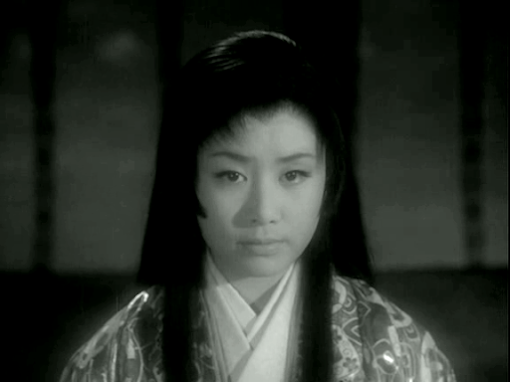 Hibari Misora
Hibari MisoraThis Toei production set in the Heian period stars singing sensation Hibari (‘Skylark’) Misora as Princess Tamaori, a young noblewoman who travels to Kyoto with her mother, Lady Tsubaki (Chiaki Tsukioka), to meet her estranged father, Lord Tsunemori (Makoto Usami), for the first time. On the way, she stops to sing a song and attracts the attention of Prince Atsumori (Hashizo Okawa), a music-loving member of the Heike clan who whips out his flute and joins her in a duet. It’s a case of love at first sight, but when she reaches Kyoto, she’s shocked to learn that Atsumori is her half-brother by a different mother.
Meanwhile, her mother is having an affair with Lord Tokitada (Masao Hori), a wily schemer who has a plan to gain power and influence by arranging a marriage between Tamaori and Konoe Motomichi (Akashi Ushio), the chief advisor to the Emperor. Atsumori has his own troubles, too – he's being pursued by Princess Katsura (Michiko Hoshi), who is determined to marry him and won’t take no for an answer. As these personal affairs become increasingly problematic, war breaks out between the Heike clan and their rivals, the Genji clan…
Although technically this could be labelled a musical, there are no big Hollywood-style production numbers, just occasional pauses for Hibari to sing part of a song. Like her counterpart Chiemi Eri (born the same year), Hibari also had some acting ability, and she’s especially convincing in a scene towards the end in which she suffers an emotional breakdown. For the rest of the picture, she seems more subdued than usual, perhaps because she’s playing quite an unhappy character. On the other hand, maybe she was just knackered as she was starring in ten films a year at this point. In any case, it’s Michiko Hoshi who steals the film here as her tactless, insinuating, bitchy rival. She comes as something of a breath of fresh air in contrast to the other characters, who are mostly solemn and rather dull, especially the flute-playing warrior himself. At the time of writing, Michiko Hoshi is still with us at the age of 97.
The literary source is a play by Hideji Hojo (1902-96), who based many of his works on The Tale of Genji, which seems also to have been the case here. The director, Yasushi Sasaki (1908-93), was a veteran who specialised in period films and directed around 20 Hibari vehicles. With a reputation for working quickly and making commercially successful movies, he was highly valued by the studios he worked for, but made little dent on film history. Nevertheless, The Flute-Playing Warrior remains an enjoyable piece of entertainment from a bygone era.
January 19, 2024
Nemuri Kyoshiro – Journal of an Outlaw / 眠狂四郎 無頼控 / Nemuri Kyôshirô burai hikae (aka The Lonely Swordsman Part 1, 1956)
Obscure Japanese Film #97
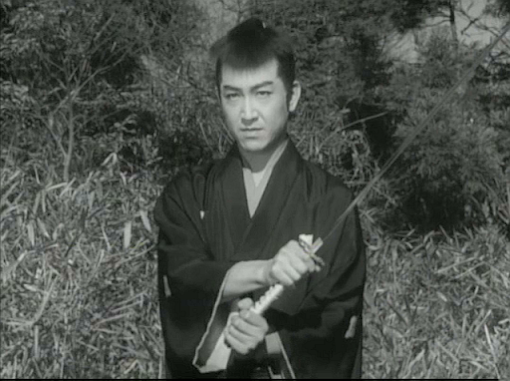 Koji Tsuruta
Koji TsurutaThis Toho production was the first film based on the seriesof novels about Kyoshiro Nemuri, a fictional swordsman created by RenzaburoShibata (1917-78) in the same year this film was released. The character laterbecame the hero of a series of films starring Raizo Ichikawa – these are knownin the West as the Sleepy Eyes of Deathseries (‘Nemuri’ actually means ‘sleep of death’ according to Merlin David’sfirst-rate subtitles here). Shibata appears to have modelled his characterpartly on Ryunosuke Tsukue, the anti-hero of Kaizan Nakazato’s novel Dai-bosatsu toge, portrayed mostmemorably by Tatsuya Nakadai in Sword ofDoom. However, in the hands of actor Koji Tsuruta (see The Romance of Yushima), Nemuri simply comes across as an oddlyunlikeable hero, especially considering the fact that he rapes Mihoyo (KeikoTsushima) a few minutes into the film. Of course, she falls in love with him asa result (I’ve lost count of the number of times I’ve seen this dodgy cliché inJapanese films). Although there is some compensation in the fact that the womenget to do some of the fighting too (which is probably the best thing about thisfilm), unfortunately the swordfights are never very convincing and feature neithercutting sounds nor blood. This would change forever post-Yojimbo and Sanjuro, buteven though those game-changing movies were still a few years away at thispoint, I felt that director Shigeaki Hidaka (who also made World War III: 41 Hours of Fear) could have done a little better onthe action front than what we see here.
Talking of Kurosawa, the screenplay was written by his frequentcollaborator Hideo Oguni and features two of his regular actors, KamatariFujiwara and (all too briefly) Bokuzen Hidari. It’s by no means a bad film, butI found it disappointing on the whole and the plot felt both over-complicatedand implausible (this is why I couldn’t face writing a synopsis). The characterof Kiheita, ‘the flying squirrel’ (Shin Tokudaiji) is especially daft – he’s ahunchbacked swordsman who is supposedly Nemuri’s deadliest rival and can leapreally high into the air (i.e. be pulled up by wires).
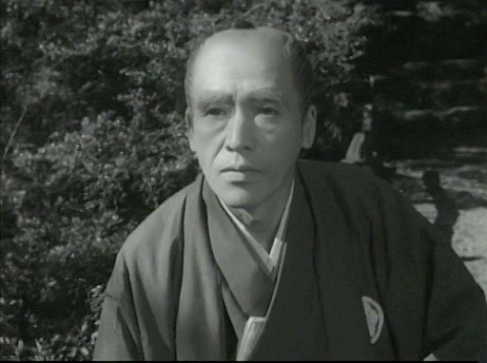 Kamatari Fujiwara
Kamatari Fujiwara
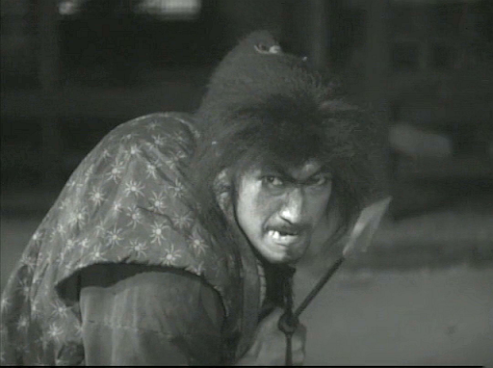 Shin Tokudaiji
Shin Tokudaiji
Koji Tsuruta starred in two sequels before Toho dropped theseries in 1958. Part 2 was shot back-to-back with this one and features many ofthe same cast members, but adds Koji Mitsui and Setsuko Wakayama, while thesecond sequel was shot in widescreen with a new director and a particularlyimpressive supporting cast including Isuzu Yamada, Haruko Sugimura and MichiyoKogure. Daiei studios revived the character with Raizo Ichikawa and greatersuccess in 1963 in a series which continued for 12 films and probably endedonly due to the premature death of their star in 1969.
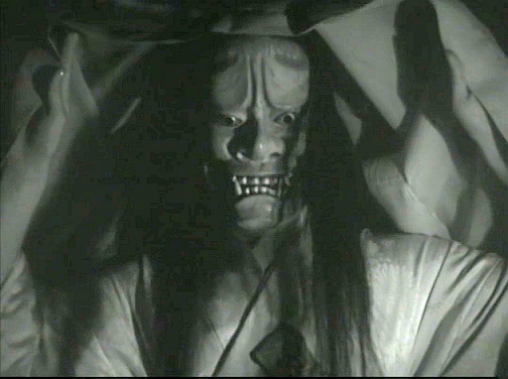
January 13, 2024
Tarao Bannai - Thirteen Demon Lords / 多羅尾伴内 十三の魔王 / Tarao Bannai – Juzo no mao (aka The Man with Thirteen Eyes, 1958)
Obscure Japanese Film #96
 Chiezo Kataoka as Tarao Bannai
Chiezo Kataoka as Tarao BannaiWhen a nightclub singeris killed under mysterious circumstances at a racetrack, master detective TaraoBannai (Chiezo Kataoka) adopts a number of disguises in an attempt to unmaskthe killer. The suspects include Dr Izumaru (Eitaro Shindo), his wife (MiekoTakamine), his assistant (Michiko Hoshi), the dead girl’s ex-lover (KenTakakura), crooked businessman Togame (Takashi Shimura) a nightclub owner (MasaoMishima), and a nightclub hostess (Mitsuko Miura).
 Michiko Hoshi
Michiko Hoshi Eitaro Shindo
Eitaro Shindo Masao Mishima
Masao Mishima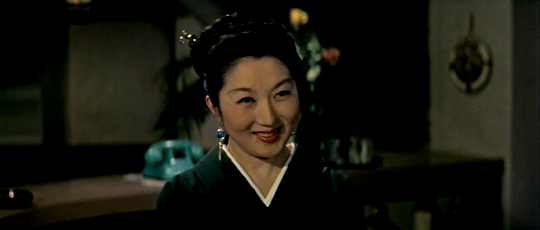 Mitsuko Miura
Mitsuko MiuraThe character of TaraoBannai was created for the movies in 1946 by screenwriter Yoshitake Hisa(1904-81) in order to provide a new vehicle for veteran star Chiezo Kataoka.After the war, the occupying Americans had banned sword-fighting films in thebelief that they encouraged feudalism, leaving Kataoka unable to perform the typeof roles for which he was famous. Fortunately for Kataoka, the first film was ahit with the public if not with the critics. He starred in four Tarao Bannai pictures forDaiei in the late ‘40s; when he later fell out with the studio, he made afurther seven films featuring the character for Toei between 1953 and 1960. Thirteen Demon Lords was the first ofthese to be shot in colour and widescreen, and perhaps for that reason it boastsa remarkably strong cast including a young Ken Takakura, veteran star andrespected actress Mieko Takamine, and Kurosawa favourite Takashi Shimura.However, despite such stiff competition, this is Kataoka’s show all the way.
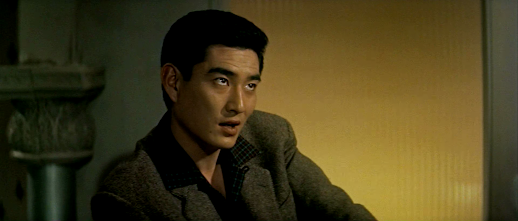 Ken Takakura
Ken Takakura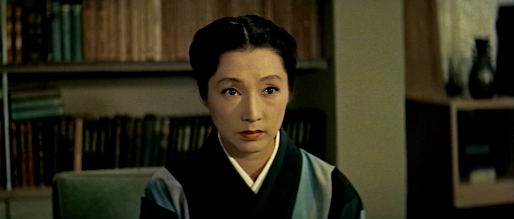 Mieko Takamine
Mieko Takamine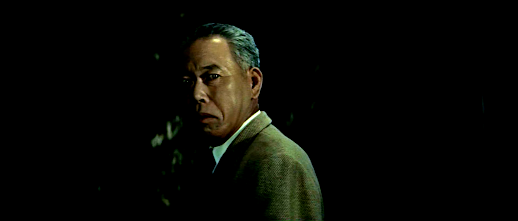 Takashi Shimura
Takashi ShimuraOutside of Japan,Chiezo Kataoka is perhaps best-known for his leading roles in a number of TomuUchida films, the most widely-seen of which is probably Bloody Spear at Mount Fuji, though he also played the nihilisticsamurai Ryunosuke Tsukue in Uchida’s three-film version of the novel Daibosatsu Toge – a character laterimmortalised by Tatsuya Nakadai in Swordof Doom. He was a wonderfully versatile actor as we can see from hisperformance (or performances) in ThirteenDemon Lords. Although the disguises that his character adopts (an Indianmagician, a beatnik artist, etc) are often utterly ridiculous, the extent to which Kataoka not onlychanges his appearance, but subtly alters his voice and body language each time is impressive.If it’s not too confusing, it should perhaps be noted that the character ofTarao Bannai himself is actually another alter-ego – the ‘real’ person behindthe different faces is one Daizo Fujimura, a former jewel thief who has turned hisback on his criminal past to become a crusader for justice.
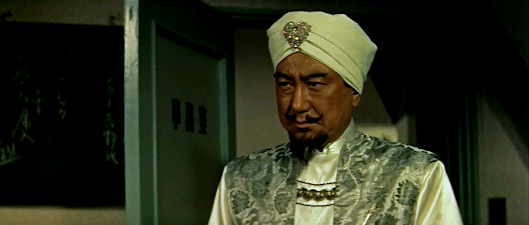 Chiezo Kataoka
Chiezo Kataoka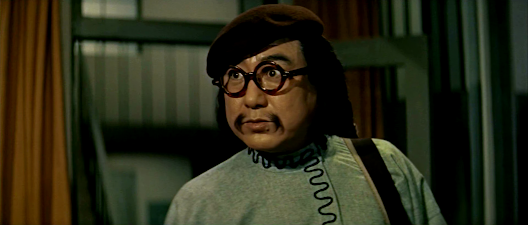 Chiezo Kataoka
Chiezo Kataoka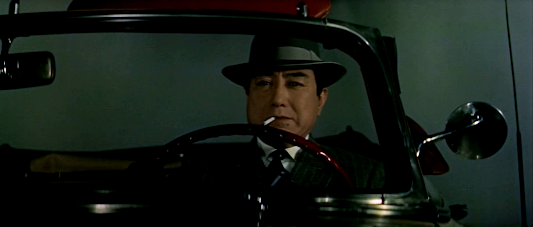 Kataoka as Daizo Fujimura
Kataoka as Daizo FujimuraWith its unlikelynick-of-time escapes and evil criminal mastermind who relishes the use ofpoison gas and dripping acid, this recalls the serials of the 1920s and ‘30sand is, of course, pure hokum, but it’s also pretty good fun if you’re in themood. However, I’m not sure I’d want to sit through the other ten movies in theseries as they apparently followed a pretty rigid formula, with Bannai adoptingthe same number of disguises each time (always seven) and departing in the samemanner at the end of each film, although this very repetition seems to havebecome an element that the Japanese audiences of the time enjoyed.
Director SadatsuguMatsuda (1906-2003) directed most of the entries in the series and divided histime between this sort of film and chanbaraflicks. The character was briefly revived for two films in 1978 starring AkiraKobayashi, but did not catch on.
Watched with dodgy subtitles.
January 8, 2024
Joshu karasu / 上州鴉 ('Crow of Joshu', 1951)
Obscure Japanese Film #95
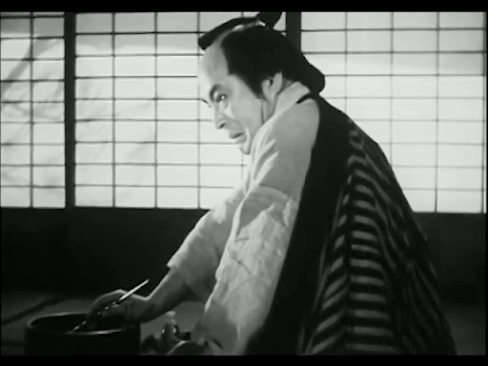 Denjiro Okochi
Denjiro OkochiThis Daiei production stars silent screen veteran Denjiro Okochi as Takizo, a wandering samurai and master swordsman who returns incognito to the town where he was born, hoping to shake off some men pursuing him. Once there, he meets Sahei (Koichi Katsuragi), a widowed farmer, to whom he will later confess that his mother (now deceased) was a maid who became pregnant by a criminal and had to give birth to him in a warehouse.
Sahei has two daughters, Okimi (Michiko Hoshi) and Omitsu (Kazuko Takamori). Unable to pay the annual tax, Sahei asks government official Yamagataya (Ryanosuke Higashi) to take Omitsu in as an indentured servant instead. Yamagataya agrees, but secretly intends to pimp her out.
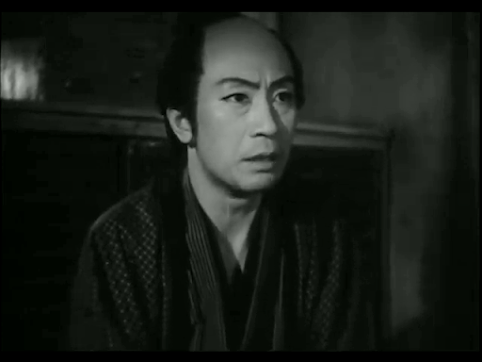 Kotaro Bando
Kotaro Bando
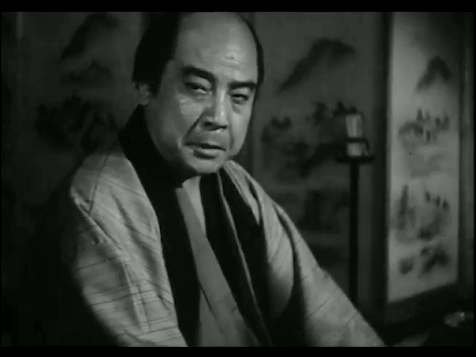 Ramon Mitsusaburo
Ramon Mitsusaburo
Meanwhile, Inoyuki (Kotaro Bando) visits a gambling den owned by Hikigoro (Ramon Mitsusaburo from The Mysterious Edogawa Ranzan) in an attempt to raise money so that his sick wife Okichi (Mitsuko Mito) can take a rest, but he loses and is tricked into signing Okichi over to Hikigoro. Observing the way the innocent townspeople are abused and cheated by the powerful and corrupt, Takizo decides that it’s time to for him to come out of hiding and intervene…
Based on an original work by Shintaro Mimura, the screenplay was written by Kaneto Shindo, who must not only have been the most prolific screenwriter of all time, but who also maintained an impressively high standard throughout his 70-year career. Director Taizo Fuyushima (1901-81) was new to me, but on this evidence he seems worthy of further investigation as Joshu karasu features excellent mobile camerawork courtesy of Yasukazu Takemura, some very well-co-ordinated and complex staging, a lively sense of rhythm in the editing and a strong ensemble cast, including that reliable old scene-stealer Daisuke Kato as a travelling con artist.
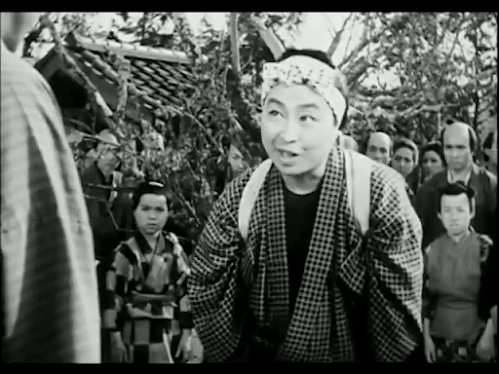 Daisuke Kato
Daisuke Kato
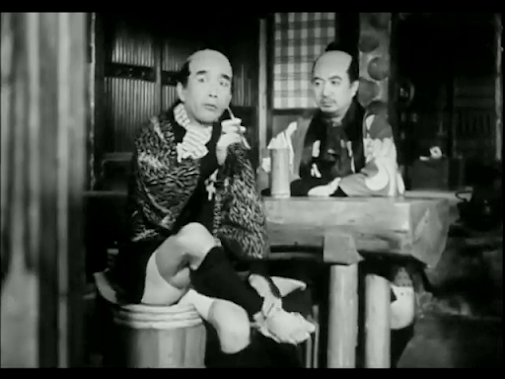 Atsushi Watanabe and Toshiaki Konoe
Atsushi Watanabe and Toshiaki Konoe
Atsushi Watanabe and Toshiaki Konoe are also great fun as a couple of oddball palanquin carriers, one of whom has a topknot with a life of its own. The fight scenes are well above-average for 1951, too – one even takes place in heavy rain, which would soon become a Kurosawa trademark (not the only time this film brought Kurosawa to mind).
It’s a marvel how the Japanese cinema of this period appears to have been populated with an almost endless number of excellent directors of whom we’ve never heard. Taizo Fuyushima’s career stretched back to 1926 and he directed over 90 films, mainly period dramas, but he seems to be almost completely forgotten. After his retirement, he made kabuki paper dolls, at which he was considered a master, and took on a number of pupils.
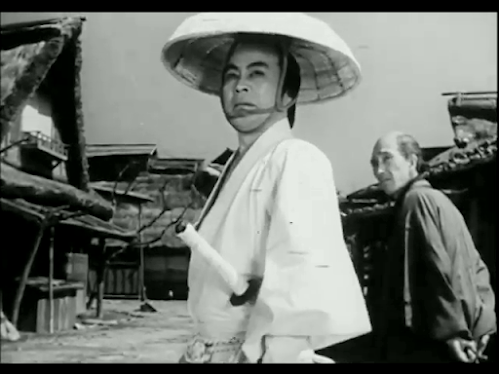 Denjiro Okochi and Koichi Katsuragi
Denjiro Okochi and Koichi Katsuragi
Watched without subtitles.
Available on YouTube here.
January 3, 2024
Wedding Day / 嫁ぐ日 / Totsugu hi (1956)
Obscure Japanese Film #94
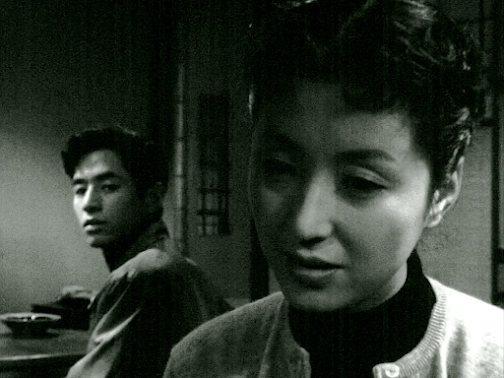 Masami Taura and Keiko Tsushima
Masami Taura and Keiko Tsushima
Sakie (Keiko Tsushima) is a young widow living with herfather-in-law, Shinsaku Kijima (Tatsuo Saito), and his family. Kijima is aformerly successful playwright whose confidence has vanished in the post-waryears; seen as a progressive in his heyday, his ideas are now regarded ashopelessly out-of-date. Unbeknownst to Kijima, Sakie pays a visit to Haiyuza(the real-life theatre company which trained Tatsuya Nakadai among many others)and asks director Mizuno (Seiji Miyaguchi) if he would help to get Kijima outof his funk by requesting a new play from him. Meanwhile, the rest of thefamily think it’s time that Sakie got married again and believe they’ve foundthe perfect candidate…
Although distributed by Shochiku, this is an independentproduction by Kindai Eiga Kyokai, the company formed by director KozaburoYoshimura, screenwriter Kaneto Shindo and actor Taiji Tonoyama in 1950, andwhich went on to produce films such as TheNaked Island (1960) and Onibaba(1964).
The modest story of WeddingDay may seem inconsequential, but it’s well done in all departments and apleasure to watch. Perhaps the best thing about it is that it provided roleswith depth for two underrated actors: Tatsuo Saito, who had starred in many ofOzu’s earlier works, and Keiko Tsushima, best-known for playing the beautifuldaughter of one of the farmers in SevenSamurai. She also played the ‘stripper’ who doesn’t actually strip in TomuUchida’s Twilight Saloon.
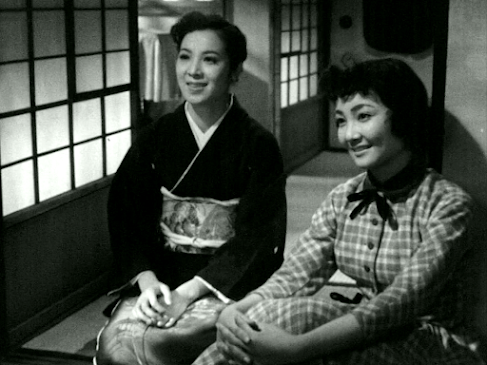 Sumiko Hidaka and Kurumi Yamabato
Sumiko Hidaka and Kurumi Yamabato
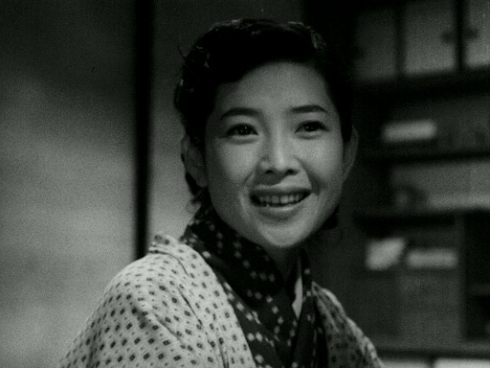 Setsuko Wakayama
Setsuko Wakayama
Also notable among the cast are the actresses playing Kijima’sthree daughters: Sumiko Hidaka (the hard-working one), Kurumi Yamabato (thelazy tomboyish one) and Setsuko Wakayama (the one who has a miscarriage but remainscheerful). Hayuza's Masami Taura is effective, too, as the son who has a crush on Sakie.
Director Kozaburo Yoshimura and his cast clearly went to greatpains to make the characters convincing as fully-rounded human beings – note,for example, how the dialogue scenes usually involve someone carrying out achore of some kind while speaking, or the troubled expression that sometimespasses across Sakie’s face – but only when she’s alone.
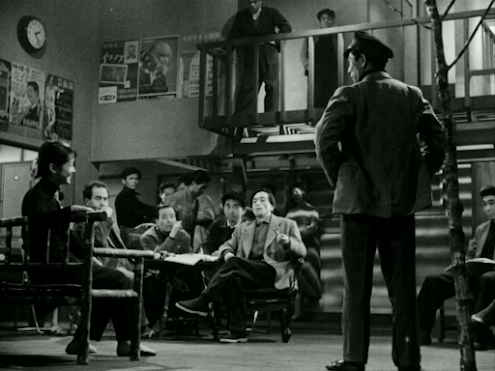 Kaneko Iwasaki, Eitaro Ozawa, Seiji Miyaguchi and others
Kaneko Iwasaki, Eitaro Ozawa, Seiji Miyaguchi and others
Recommended viewing for fans of Ozu and Naruse, Wedding Day should also be of interest toJapanese theatre buffs as Haiyuza founders Chieko Higashiyama and Eitaro Ozawa bothmake appearances (although Ozawa has no lines and is only glimpsed briefly),while Haiyuza member Kaneko Iwasaki is seen rehearsing the part of Anya in The Cherry Orchard – a role she hadactually performed for the company five years earlier.
December 30, 2023
Escape from Hell / 無宿人別帳/ Mushukunin-betsucho (1963)
Obscure Japanese Film #93
 Keiji Sada
Keiji SadaDuring the winter of1802-3, a group of convicts are transported in individual bamboo cages to theisland of Sado, where they have been sentenced to hard labour draining a gold mine.Among them is Yaju (Keiji Sada), a formerly honourable samurai who became acriminal after the woman he loved, Kumi (Mariko Okada), was forced into amarriage with the more senior Kurozuka (Hiroshi Nihonyanagi).
 Hiroshi Nihonyanagi and Mariko Okada
Hiroshi Nihonyanagi and Mariko Okada
In an unfortunatecoincidence, Kurozuka becomes the new governor of the mine, while his schemingsubordinate Kojuro (Hiroyuki Nagato) informs Kumi that her former lover Yaju isamong the prisoners. Always planning ahead, Kojuro also decides it could be tohis advantage to push his own mistress, Rin (Sachiko Hidari), into the arms ofthe inexperienced new magistrate.
 Hiroyuki Nagato and Sachiko Hidari
Hiroyuki Nagato and Sachiko Hidari
Meanwhile, theprisoners find themselves not only working in life-threatening conditions, butalso treated brutally by the foreman (Ko Nishimura) and his henchman Hachizo (ToranosukeTennoji).
 Rentaro Mikuni and Kanemon Nakamura
Rentaro Mikuni and Kanemon Nakamura
However, two trusties,Shinpei (Rentaro Mikuni) and Seibei (Kanemon Nakamura) are more sympathetic anddo what they can for the men. Seibei also has a daughter, Miyo (Masuyo Iwamoto*),who treats the men when they are wounded, but is raped by one named Senta(Masahiko Tsugawa) for her pains. When conditions become unbearable, the mendecide to make a desperate escape attempt headed by Shinpei – but can the trusty betrusted?
This Shochikuproduction takes its Japanese title from the title of Seicho Matsumoto’s 1958 shortstory collection containing the story ‘Tobo’ (‘Escape’) upon which the film is partlybased. The title is hard to translate into English, but in the Edo periodduring which the stories were set, the mushukuninwere people who had been removed from the family register, and each of thestories in Matsumoto’s collection was centred on a character who was some kindof social outcast, i.e. a homeless person or criminal. However, the film isalso partly based on a second Matsumoto story, ‘Sado runinko’ (‘Sado Exile Journey’),published in 1957. I’m uncertain whether there was really a mass escape attemptat the Sado gold mine, but it’s certainly true that, during the late Edoperiod, the authorities would round up vagrants and send them to do forcedlabour there. In any case, the man who used this interesting historical settingalong with other elements of the two Matsumoto stories and turned it all into afine screenplay was Hideo Oguni, known for his work on many of Kurosawa’s mostfamous films.
The director, KazuoInoue (1924-2011), had worked as an assistant to Minoru Shibuya, Yuzu Kawashimaand Yasujiro Ozu before becoming a Shochiku director himself in 1954. Escape from Hell is the 11thof 12 films he made for the company before going freelance in 1964, after whichhe seems to have been unable to sustain a career in the declining Japanese filmindustry. Although he managed to direct a further eight pictures, most of thesewere comedies of little note, the exception being his final film, a documentaryabout Ozu entitled I Lived But… (1983).Apart from allowing some of the actors in the smaller parts to overact, hisdirection of Escape from Hell isimpressive and he clearly knew how to get the most out of a scene.
Another factor whichmakes Escape from Hell worthseeking out is the host of well-knownfaces among the cast, even including Tora-san actor Kiyoshi Atsumi as a convictwith a snoring problem. Hiroyuki Nagato from Pigs and Battleships is especially good as the devious Kojuro,constantly figuring all the angles to his own advantage, although Mariko Okadais sadly wasted in her role, which gives her little to do. Used to betteradvantage is Rentaro Mikuni, who gives one of the strongest performances hereas an escaping convict. This fact, together with Sachiko Hidari’s appearance asa giggling former prostitute, suggests that Tomu Uchida saw the film and wasinfluenced in his casting for A Fugitivefrom the Past (1965).
However, the real revelation for me among the cast wasKeiji Sada – I’ve seen many of his films and always liked him, but would neverhave imagined Sada as the tough, unshaven, moody samurai he plays here, a rolehe pulls off very well indeed. It’s a reminder of what a loss to Japanesecinema his premature death in a car crash the following year was.
*Sometimes incorrectlylisted as Tayo Iwamoto in English.
December 20, 2023
World War III: 41 Hours of Fear / 第三次世界大戦 四十一時間の恐怖 / Dai-sanji sekai taisen: Shi jū-ichi jikan no kyōfu (1960)
Obscure Japanese Film #92
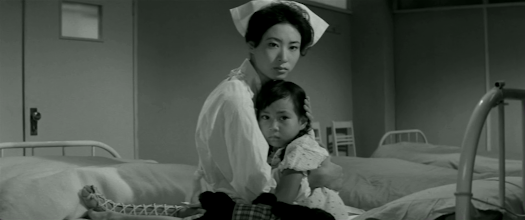 Yoshiko Mita
Yoshiko MitaBased on a magazinearticle, this Toei production opens with a shot (inside a church) of a statuteof the Virgin Mary holding the baby Jesus. ‘As long as humanity has aconscience, World War III will never happen’ reads the subtitle before the maintitle flashes up, undermining the previous statement to read: ‘World War III:41 Hours of Fear’. After the main credits play out against a background ofrising smoke, we see several still images of children killed by the atom bomb.This segues into a high school lecture in which the teacher expresses concernthat the rise in juvenile delinquency and its accompanying aggressive attitudescould lead to an increased threat of nuclear war in the future. However,subsequent scenes reveal that it’s actually anxiety about nuclear war that isat least partly responsible for the nihilistic outlook fuelling thedelinquency, although not all of the students are reacting in the same way.
Three young malestudents take a boat out on Tokyo Bay and talk about sailing to Africa toescape the nuclear threat. When they are caught in a typhoon and have to berescued, the press use their story as an example of the all-pervadingatmosphere of dread the youth are living in. Soon, their worst fears arerealised: North Korea shoots down an American plane carrying a nuclear weaponover South Korea, killing thousands on the ground. Events escalate rapidly andit looks like World War III will begin at any moment…
Given the scant 77-minuterunning time and the lack of big names among the cast, I had expected a sillyB-movie, but was surprised to find a fairly intelligent, well-made, sober filmwith a deadly serious anti-war message. Although it’s not really a big specialeffects movie either, there is a bit of that toward the end (combined withstock footage), and what there is of it is well done.
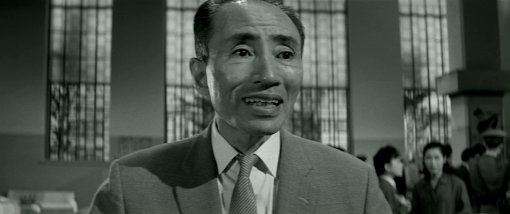 Yoshi Kato (former husband of Isuzu Yamada)
Yoshi Kato (former husband of Isuzu Yamada)
This is an ensemblepiece with no real stars, but among the characters whose destinies we followare a young reporter, Masaki (Tatsuo Umemiya), and his girlfriend, Tomoko(Yoshiko Mita), who works as a nurse, together with high school students Mie (Yukiko Nikaido) and Shigeo (Norifumi Fujishima), his sister Shizuko (Yayoi Furusato) and father (Yoshi Kato), and musician Tonomura(Junji Masuda) and his sick wife, Keiko (Michiko Hoshi). The ending of the filmfeatures another scene inside a Christian church in which Keiko is singing ahymn along with the rest of the congregation, but I’m at a loss to account forthis film’s emphasis on Christianity. Perhaps the director was a Christian, or maybe they thought it would help distribution abroad. In any case, the acting is generally good, with MichikoHoshi being a stand-out.
Director ShigeakiHidaka (1916-?) had studied under Teinsouke Kinugasa and worked as ChiefAssistant Director to Kenji Mizoguchi on TheLady from Musashino (1951). He directed 18 films between 1955-1962, firstfor Toho, then for Toei, and on this evidence he clearly knew what he wasdoing. The brief scenes featuring American actors speaking English weredirected by William Ross, an American actor based in Japan.
The film was bought byan American company who dubbed over the Japanese actors and added scenes fromanother Japanese film, Invasion of theNeptune Men (1961), including – inexplicably – flying saucers! This wasreleased in the States as The Final Warin 1962, but is now (perhaps thankfully) believed lost. The original, at least,is a fascinating time-capsule which sheds light on the mindset of the era andalso holds up surprisingly well as a film drama. It may be a little simplistic, but it certainly gets its message across and does so in a compact way without outstaying its welcome.
The following year, Toho released a similarly-themed film entitled Sekai daisenso (aka The Last War), which I've yet to see.
December 10, 2023
Black Torrent/ 黒の奔流 / Kuro no honryu (1972)
Obscure Japanese Film #91
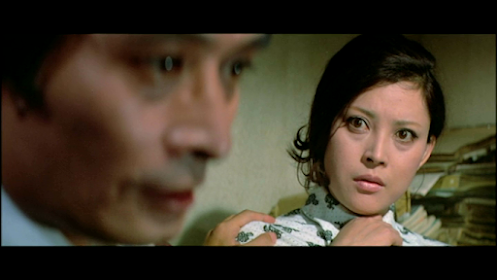 Tsutomu Yamazaki and Mariko Okada
Tsutomu Yamazaki and Mariko OkadaTakeshi Yano (Tsutomu Yamazaki) is an ambitious but strugglinglawyer whose office shakes every time a train goes past on the tracks outside.He’s in a casual relationship with his pragmatic assistant Yukiko (KaoruTaniguchi) but hopes to marry Tomoko (Keiko Matsuzaka), the daughter ofMasamichi Wakamiya (Tatsuo Matsumura), the head of a law firm.
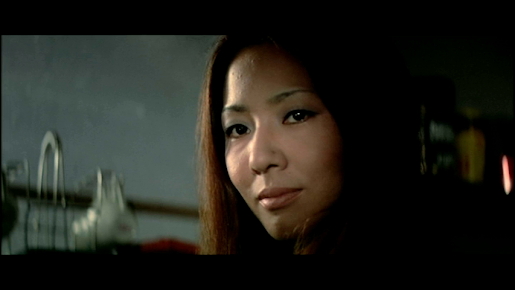 Kaoru Taniguchi
Kaoru Taniguchi
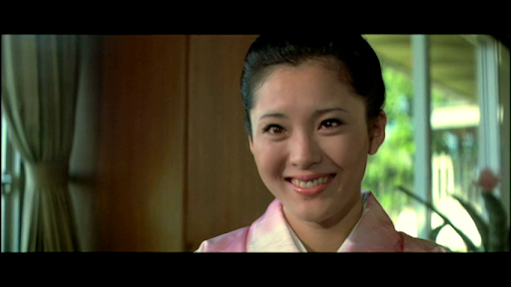 Keiko Matsuzaka
Keiko Matsuzaka
When the stateneeds someone to defend Fujie Kaizuka (Mariko Okada), a maid accused of murder,Yano agrees although the pay is negligible because he hopes that defeating tough prosecutor Kuraishi (Kei Sato) will be his chance to impress Tomoko’s father and turn his luck around. However,when he finds himself attracted to Fujie, things become complicated…
To reveal any more of the plot would spoil things as this is oneof those crime dramas in which the twists are pretty much the raison d’etre. Based on a 1967 shortstory by Seicho Matsumoto entitled ‘Shuzoku domei’ (‘Tribal Alliance’), Black Torrent is a Shochiku production reminiscentof the films of director Yoshitaro Nomura, who frequently adapted Matsumoto’swork for the screen. The director of this film, Yusuke Watanabe (workingtogether with co-writer Takeo Kunihiro), changed the details of the originalstory considerably and transformed the character of the defendant from a maleto a female. This is probably a good thing as it created an interesting rolefor the great Mariko Okada, who turns in her usual highly convincingperformance (and appears able to turn on the waterworks at the drop of a hat).
Her co-star, Tsutomu Yamazaki, is slightly less effective as he overacts alittle at times and his expressions are sometimes unintentionally comical. Iactually blame the director for this – Yamazaki (the kidnapper from Kurosawa's High and Low) is a very talented actor, buteven the best actors need good guidance. However, in regard to other aspects,this is a well-directed film, and the cinematography by Masahiro Shinodafavourite Masao Kosugi is also a strong point. The music, on the other hand, isa detriment as it seems to be alternately emulating spy movies and spaghettiWesterns – even using a harmonica and Jew’s harp at times – none of which feelsappropriate. Still, despite a few flaws, this is worth seeing for Mariko Okadaand the enjoyably twisty plot.
Intriguingly, the previously-reviewed Kao was also an adaptation of a Matsumoto story which transformedthe central character from a male to a female played by Mariko Okada. Perhaps Okadafelt some affinity for his work, as she also appeared in a number of TV versionsof the author’s stories as well as a further feature film, Mushukunin-betsucho (1963).
For more on director Yusuke Watanabe, see my review of Wild Detective.
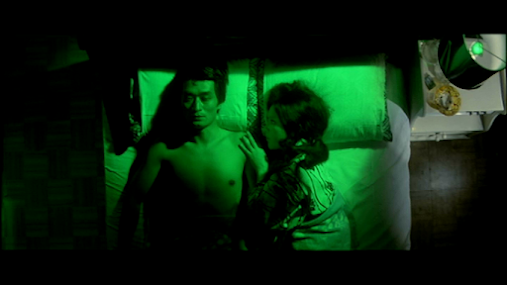 Tsutomu Yamazaki and Mariko Okada
Tsutomu Yamazaki and Mariko Okada
December 4, 2023
The Romance of Yushima / 婦系図 湯島の白梅 / Onna keizu Yushima no shiraume (1955)
Obscure Japanese Film #90
Yushima, Tokyo, 1902.Otsuta (Fujiko Yamamoto) is a geisha who has left her profession to become thewife of promising young scholar Hayase (Koji Tsuruta), who is helping hismentor, Professor Sakai (Masayuki Mori), to compile the first German-Japanesedictionary. Otsuta and Hayase have not yet been married officially as Hayase is waiting for an opportune moment to tell the Professor about their union. Havinglost his parents in the fire which destroyed much of downtown Shizuoka in 1889,Hayase was adopted by the Professor, and so is under a great obligation to him.However, as the Professor thinks highly of Hayase, the young couple areconfident that he will approve their union even though Hayase is expected tomarry the professor’s daughter, Taeko (Yoshiko [not Sumiko] Fujita). Unfortunately,Otsuta becomes implicated in a theft despite being innocent. When this isreported in the newspaper, Professor Sakai learns about the secret marriage andis furious, seemingly forgetting the similar relationship he had had in his ownyouth with Koyoshi (Haruko Sugimura), who is actually the madam at the geishahouse where Otsuta had been employed…
This Daiei productionhas the sort of determinedly tragic story that is (or at least was) especiallypopular in Japan. I found it rather clichéd and predictable, but it should benoted that it’s a faithful adaptation of a 1907 novel by Kyoka Izumi, so it’squite possible that Izumi’s work felt fresh at the time and it was only whenothers copied aspects of it that they became clichés. What now seems a quaintlyold-fashioned story was also once considered progressive in its attack on theinstitution of the arranged marriage. Although it’s not one of the few Izumiworks to have been translated into English (he’s reputedly difficult to translate),it was one of his most popular and became a successful stage play only a yearafter publication. There had also been previous film versions – in 1934 withKinuyo Tanaka and Joji Oka, followed by a two-part version in 1942 with IsuzuYamada and Kazuo Hasegawa. Remakes followed in 1959 and 1962, while it wasalso adapted for television on a number of occasions, including in 1966 with Fujiko Yamamoto repeating her role.
The male lead, KojiTsuruta, is not a name likely to ring many bells outside of Japan, but he wasactually one of the country’s biggest male stars of the era. Some readers mayknow him for playing Toshiro Mifune’s opponent, Kojiro Sasaki, in HiroshiInagaki’s Samurai trilogy, or perhapsfor his starring role in Kinji Fukasaku’s Sympathyfor the Underdog (1971). He could probably relate well to the part he playsin The Romance of Yushima given thathis own romance with actress Keiko Kishi was nipped in the bud in 1952 byShochiku, the studio to whom he was under contract at the time. He attemptedsuicide shortly after, but fortunately survived only to be badly beaten by a yakuzamember the following year because his manager had offended them. The attack hadinvolved both a whisky bottle and a brick; Tsuruta required 11 stitches, butluckily was not disfigured and resumed his career, which continued almost untilhis passing from lung cancer in 1987.
The performances in The Romance of Yushima are solid ifunexceptional. The omnipresent Eitaro Ozawa also pops up as a colleague ofSakai’s, but it’s actually Daisuke Kato who steals it as a cheeky fishmonger sympatheticto Otsuta.
The print I saw was ajust-about-watchable VHS transfer, so there’s no doubt that the film wouldbenefit greatly from a higher quality digital version. However, I wouldn’t callit a lost masterpiece as the story hasn’t dated well and the music (acombination of choral singing, harp and strings) is overused and far fromideal. For those reasons, I feel that this is my least favourite of the films I’veseen by director Teinosuke Kinugasa (the others being A Page of Madness, Gate ofHell, New Tales of the Heike: ThreeWomen around Yoshinaka and Actress).
Note: the Japanesetitle translates as ‘Genealogy of Women: White Plum Blossoms of Yushima’

